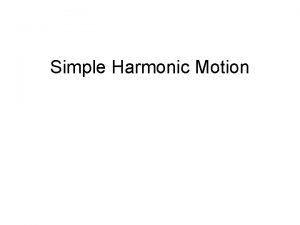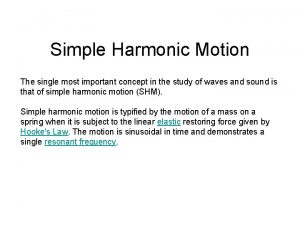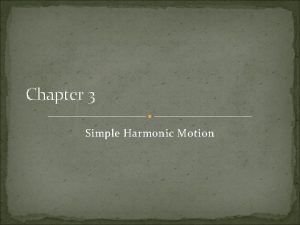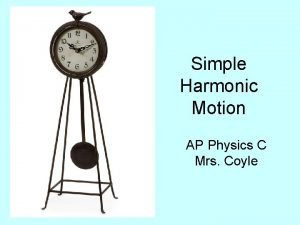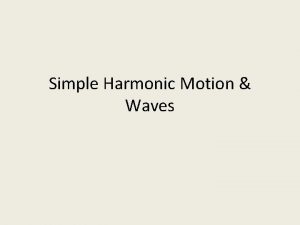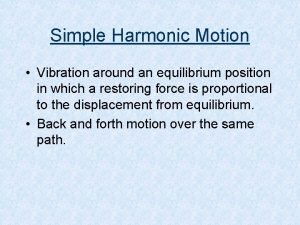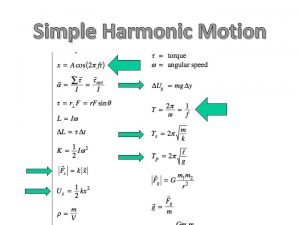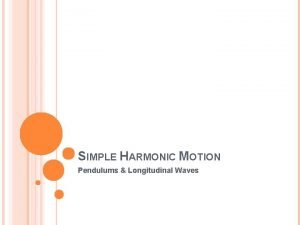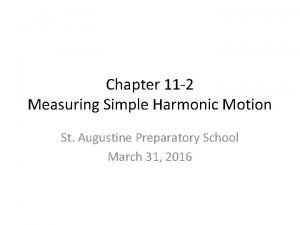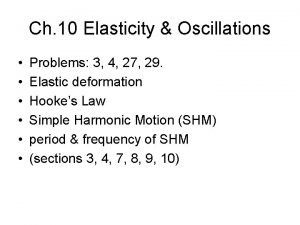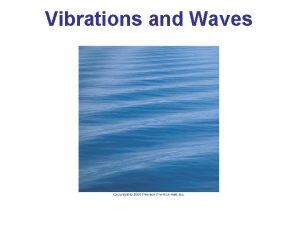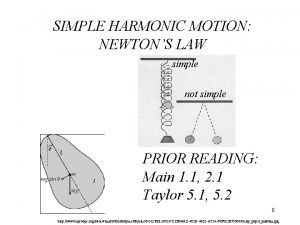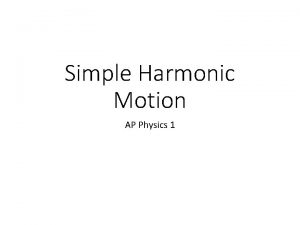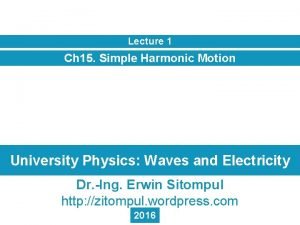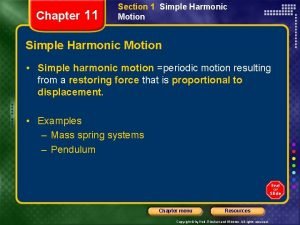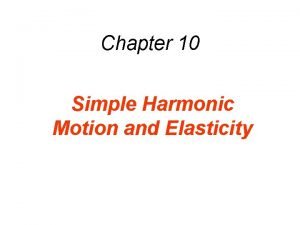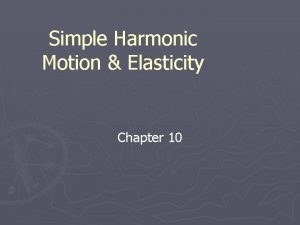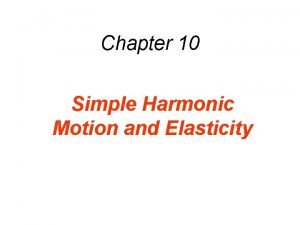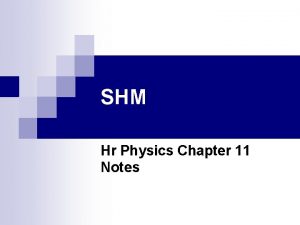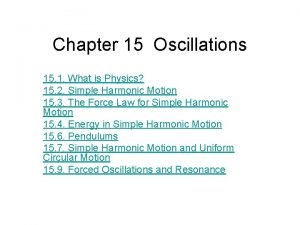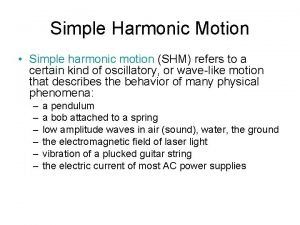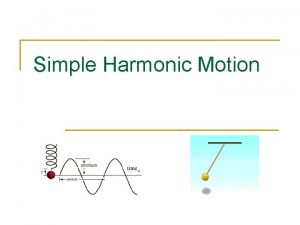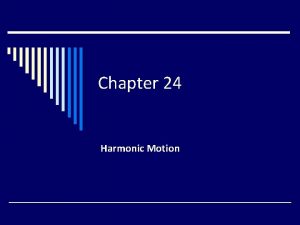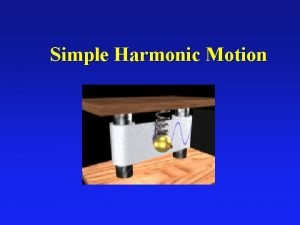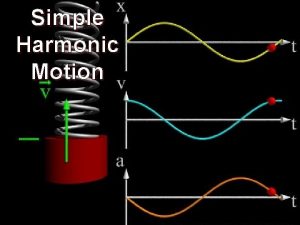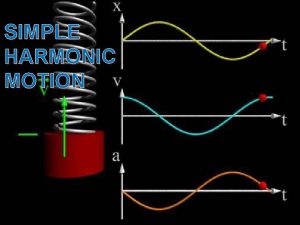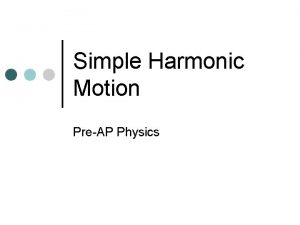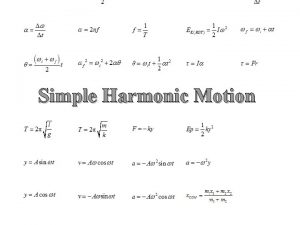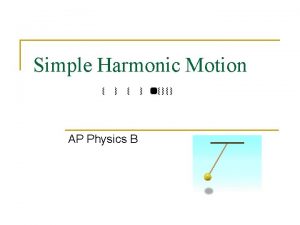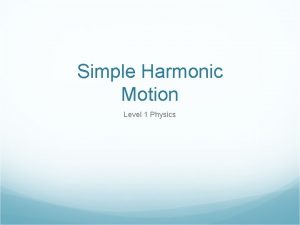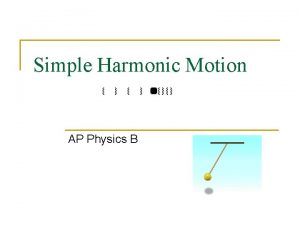Simple Harmonic Motion Springs So the equation force






























- Slides: 30

Simple Harmonic Motion

Springs • So the equation force of a spring is as follows: F = kx (Hooke’s Law) F – the force supplied by the spring k – the spring constant (depends on how the spring is made) x – displacement of the spring from its equilibrium position

Spring Example 1 I have a slinky with a spring constant of 100 N/m. If I stretch the slinky 5 meters from its equilibrium position, with what force will the spring pull on my hand? F = kx F = (100 N/m)(5 m) = 500 N F = 500 N

Period • The period of a spring system is given by the equation below: T= T – the period of motion m – Mass of the body attached k – spring contant

Spring Example 2 • What is the mass of my car if the shocks have a spring constant of 6000 N/m and it oscillates with a period of 2 seconds when I hit a bump in the road? T= (T/2π)2 = m/k (6000 N/m)(2 s/2π)2 = m 607. 93 kg = m

Restoring Force The restoring force for a pendulum is the component of gravity that is tangent to its circular motion. In most cases: F = mgsin(Θ)

Pendulum Example 1 • What restoring force does gravity supply to a 0. 5 kg pendulum that is at 30 degrees? F = mgsin(Θ) F = (. 5 kg)(9. 8 m/s 2)sin(30) F = 2. 45 N • What is the restoring force at 90 degrees? F = mgsin(Θ) F = (. 5 kg)(9. 8 m/s 2)sin(90) F = 4. 9 N

Period • The period of a pendulum is given by the following formula: T= L – Length of the Pendulum g – Acceleration due to Gravity T – Period

Pendulum Example 2 • I find an old grandfather clock with a period of 1. 0 s per swing. If the grandfather clock is located in Montgomery (g = 9. 8 m/s 2), how long is the pendulum? T= (T/(2π))2 = L/g g(T/(2π))2 = L (9. 8 m/s 2)(1 s/(2π))2 = L 0. 25 m


Example 1: A 2 kg body is tied to the end of a cord and whirled in a horizontal circle of radius 2 m. If the body makes three complete revolutions every second, determine its period and linear speed m = 2 kg r=2 m f = 3 rev/s = 0. 33 s = 37. 70 m/s

Example 2: A ball is whirled at the end of a string in a horizontal circle 60 cm in radius at the rate of 1 revolution every 2 s. Find the ball's centripetal acceleration. = 5. 92 m/s 2

Example 3: A 1000 -kg car rounds a turn of radius 30 m at a velocity of 9 m/s a. How much centripetal force is required? m = 1000 kg r = 30 m v = 9 m/s = 2700 N b. Where does this force come from? Force of friction between tires and road.


Example 4: A geosynchronous satellite is one that stays above the same point on the equator of the Earth. Determine: a. The height above the Earth’s surface such a satellite must orbit and FUG = FC m. E = 5. 98 x 1024 kg RE = 6. 38 x 106 m T = 1 day = 86400 s GMET 2 = 4 π2 r 3 r = 4. 23 x 107 m from the Earth’s center

height = r - r. E = 4. 23 x 107 - 6. 38 x 106 m = 3. 59 x 107 m b. The satellite’s speed = 3072. 54 m/s

Example 5: A 2 -kg mass swings in a horizontal circle at the end of a cord of length 10 m. What is the constant speed of the mass if the rope makes an angle of 300 with the vertical? 1. Draw & label sketch. q = 300 2. Recall formula for pendulum. L q h T Find: v = ? R 3. To use this formula, we need to find R = ? R = L sin 300 = (10 m)(0. 5) R=5 m

Example 5(Cont. ): Find v for q = 300 4. Use given info to find the velocity at 300. R=5 m Solve for v=? g = 9. 8 m/s 2 q = 300 T L q R=5 m h R v = 5. 32 m/s

Example 5 B: Now find the tension T in the cord if m = 2 kg, q = 300, and L = 10 m. T cos q L q 2 kg T T= q h mg R SFy = 0: mg cos q T cos q - mg = 0; = T (2 kg)(9. 8 m/s 2) cos 300 T sin q T cos q = mg T = 22. 6 N

Example 5 extra: Find the centripetal force Fc for the previous example. q = 300 2 kg T cos q L q h T Fc q mg R T T sin q m = 2 kg; v = 5. 32 m/s; R = 5 m; T = 22. 6 N Fc = mv 2 R or Fc = T sin 300 Fc = 11. 32 N

HOMEWORK: 1 -4

Circular Motion-2

Example 6: A car negotiates a turn of radius 70 m when the coefficient of static friction is 0. 7. What is the maximum speed to avoid slipping? m v Fc R ms = 0. 7 Fc = mv 2 R fs = msmg From which: v = msg. R g = 9. 8 m/s 2; R = 70 m v = 21. 91 m/s

Example 8: A car negotiates a turn of radius 80 m. What is the optimum banking angle for this curve if the speed is to be equal to 12 m/s? m/s n mg tan q = v 2 g. R = (12 m/s)2 (9. 8 m/s 2)(80 m) q tan q = 0. 184 How might you find the centripetal force on the car, knowing its mass? q = 10. 410


Example 9: A 2 -kg rock swings in a vertical circle of radius 8 m. The speed of the rock as it passes its highest point is 10 m/s. What is tension T in rope? mg + T = At Top: v mg T R T= v T = 25 N - 19. 6 N mv 2 R - mg - T = 5. 40 N The force are least here

Example 9 B: A 2 -kg rock swings in a vertical circle of radius 8 m. The speed of the rock as it passes its lowest point is 10 m/s. What is tension T in rope? v T - mg = At Bottom: R T T= v mv 2 R + mg mg T = 25 N + 19. 6 N T = 44. 6 N The force are greatest here

Example 10: What is the critical speed vc at the top, if the 2 kg mass is to continue in a circle of radius 8 m? 0 v At Top: mg T vc occurs when T = 0 R v v= g. R = mg + T = mg = mv 2 R (9. 8 m/s 2)(8 m) vc = mv 2 R g. R vc = 8. 85 m/s

Example 11: What is the apparent weight of a 60 -kg person as she moves through the highest point when R = 45 m and the speed at that point is 6 m/s? n + v mg R Apparent weight will be the normal force at the top: mg - n= mv 2 R v n = mg - mv 2 R n = 540 N

Lab info https: //www. youtube. com/watch? v=RLh. Vq. Icl. Ugc&t=46 s https: //www. youtube. com/watch? v=m. Cxe. Oa. T 4 h. HM https: //www. youtube. com/watch? v=Juz 9 m 0 BFX 0 I
 Shm of a spring
Shm of a spring Shm equations physics
Shm equations physics Simple harmonic motion notes
Simple harmonic motion notes Damped oscillation
Damped oscillation Simple harmonic motion formula
Simple harmonic motion formula Harmonic equation physics
Harmonic equation physics Tension wave
Tension wave Simple harmonic motion vocabulary
Simple harmonic motion vocabulary Simple harmonic motion equilibrium position
Simple harmonic motion equilibrium position Reference circle shm
Reference circle shm Simple harmonic motion formula
Simple harmonic motion formula Period of simple harmonic motion
Period of simple harmonic motion Frequency of oscillation
Frequency of oscillation Mechanical energy
Mechanical energy The body of a 1275 kg car is supported
The body of a 1275 kg car is supported Frequency in simple harmonic motion
Frequency in simple harmonic motion Simple harmonic motion formula
Simple harmonic motion formula Energy of simple pendulum
Energy of simple pendulum Shm ap physics 1
Shm ap physics 1 Simple harmonic motion presentation
Simple harmonic motion presentation Simple harmonic motion lecture
Simple harmonic motion lecture Simple harmonic motion chapter 11
Simple harmonic motion chapter 11 Simple harmonic motion and elasticity
Simple harmonic motion and elasticity Simple harmonic motion and elasticity
Simple harmonic motion and elasticity Kinematics of simple harmonic motion
Kinematics of simple harmonic motion Oscillation
Oscillation A trapeze artist swings in simple harmonic
A trapeze artist swings in simple harmonic Maximum excursion from equilibrium
Maximum excursion from equilibrium What is simple harmonic motion
What is simple harmonic motion Frequency of a simple pendulum
Frequency of a simple pendulum Simple harmonic motion definition
Simple harmonic motion definition
